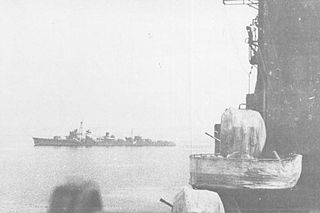Two ships of the Imperial Japanese Navy were named Itsukushima:
- Japanese cruiser Itsukushima, a Matsushima-class cruiser launched in 1889 and scrapped in 1926
- Japanese minelayer Itsukushima, a minelayer launched in 1929 and sunk in 1944
Two ships of the Imperial Japanese Navy were named Itsukushima:
Nine ships of the Royal Navy have borne the name HMS Apollo, after the Greek god Apollo:

Itsukushima (厳島) was the lead ship in the Matsushima class of protected cruisers of the Imperial Japanese Navy. Like her sister ships, the name Itsukushima comes from one of the traditional Three Views of Japan, in this case, the Itsukushima Shrine in Hiroshima prefecture on the Seto Inland Sea, home to a famous Shinto shrine dedicated to the goddess Benzaiten.

Hashidate was the third in the Matsushima class of protected cruisers in the Imperial Japanese Navy. The ship was the only one of the class constructed in Japan. Like sister ships, her name comes from one of the traditional Three Views of Japan, in this case, the Ama-no-hashidate in northern Kyoto prefecture on the Sea of Japan.
SMS Kaiser has been the name of two ships of the German Imperial Navy:

Kuroshio was the third vessel to be commissioned in the 19-vessel Kagerō-class destroyers built for the Imperial Japanese Navy in the late-1930s under the Circle Three Supplementary Naval Expansion Program.

Oyashio was the fourth vessel to be commissioned in the 19-vessel Kagerō-class destroyers built for the Imperial Japanese Navy in the late-1930s under the Circle Three Supplementary Naval Expansion Program.

Tomozuru (友鶴) was one of four Chidori-class torpedo boats of the Imperial Japanese Navy (IJN). It capsized in a storm on 12 March 1934, shortly after its completion. This incident forced the IJN to review the stability of all recently completed, under construction and planned ships. It was salvaged and put back into service after extensive modifications. During World War II, the Tomozuru fought in the Battle of the Philippines and in the Dutch East Indies campaign as an escort, and it continued to play that role for the rest of the war.
Eight ships of the Royal Navy have borne the name HMS Ariadne, after the Greek goddess:

The cruiser Bayan was the name ship of the four Bayan-class armoured cruisers built for the Imperial Russian Navy in the first decade of the 20th century. The ship had to be built in France because there was no available capacity in Russia. Bayan was assigned to the First Pacific Squadron after completion and based at Port Arthur from the end of 1903. She suffered minor damage during the Battle of Port Arthur at the beginning of the Russo-Japanese War of 1904–05 and supported destroyers as they patrolled outside the harbour. After bombarding Japanese positions in July 1904, the ship struck a mine and was out of action for the next several months. Bayan was sunk during the Siege of Port Arthur and was then salvaged by the Japanese after the war.
The 4th Fleet was a fleet of the Imperial Japanese Navy. The Fourth Fleet designation was used during three separate periods. The initial designation was for a group of ships that were assigned to work together during the Russo-Japanese conflict and the period of its immediate aftermath. The second time the designation was used was during the Sino-Japanese conflict, and the third time was as a South Pacific area of command during the middle of the Pacific War.
Seven ships of the Royal Navy have been named HMS Melpomene after the Muse of Tragedy in ancient Greek mythology.
Four ships of the Royal Navy have borne the name HMS Latona, after the Romanised name of the character Leto, of Greek mythology:

Itsukushima (厳島) was a medium-sized minelayer of the Imperial Japanese Navy, which was in service during the Second Sino-Japanese War and World War II. She was named after Itsukushima, a sacred island in Hiroshima Prefecture of Japan. She was the first warship in the Imperial Japanese Navy with all-diesel engine propulsion.

Shirataka was a medium-sized minelayer of the Imperial Japanese Navy, which was in service during the Second Sino-Japanese War and World War II. She was the world's first purpose-built anti-submarine netlayer. Also, unlike any other warship in the Japanese Navy, she had two chrysanthemum crests due to her unusual bow configuration.
Yaeyama may refer to one of several naval ships of Japan:
Several naval ships of Germany were named Brummer after the blow-fly:
Two Japanese warships have borne the name Natsushima:
Three ships of the Japanese Navy have been named Tsugaru:
Several Japanese ships have been named Tokiwa: